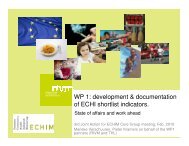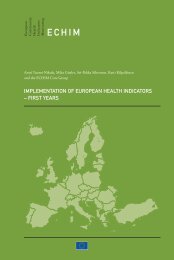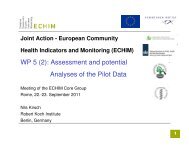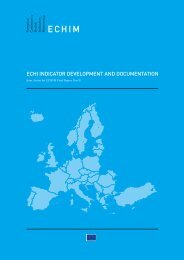INDICATORS
ECHIM Final Report
ECHIM Final Report
Create successful ePaper yourself
Turn your PDF publications into a flip-book with our unique Google optimized e-Paper software.
Calculation:<br />
1a) For adults: Lifetime prevalence and last year prevalence for use of the mentioned drugs<br />
among adults in nationwide surveys (reported to EMCDDA) among the general population.<br />
The recommended age range is 15–64 years for the whole adult population and 15 to 34<br />
years for young adults.<br />
1b) For adults: Percentage of men/women having used drugs (such cannabis, cocaine,<br />
amphetamines, ecstasy or other similar substances) during the past 12 months, derived<br />
from EHIS questions CN.2 and CN.3. CN.2: During the past 12 months, have you taken<br />
any cannabis (or term best understood by respondent? (yes/no). CN.4: During the past 12<br />
months, have you taken any other drug, such as cocaine, amphetamines, ecstasy or other<br />
similar substances? (yes/no).<br />
2) For school students: Lifetime prevalence for use of the mentioned substances among 15–<br />
16 year-old school students collected by school surveys (ESPAD, HBSC and other national<br />
surveys). The numerator is the estimation of the number of people that declare having used<br />
specified drugs in these timeframes and the denominator is the population in their respective<br />
age groups.<br />
Notes: Lifetime prevalence of drug use is a cumulative measure that includes individuals who<br />
have tried drugs in the past. For adults has limitations to assess the current situation, but<br />
for school students can be a valid indicator of the current situation. Despite limits, it gives<br />
a rough estimation of the extent of drug experience and exposure in the population,. It can<br />
help to estimate incidence (together with year of first use) and to compute basic use patterns<br />
(continuation and discontinuation rates).<br />
Last year prevalence gives information on the recent situation (in particular among adults)<br />
regarding prevalence of drug use, and it is consistent with other drug and health indicators<br />
expressed as annual prevalences.<br />
Population surveys have limitations in estimating very marginalised forms of drug use (e.g.<br />
heroin injection), or newly emerging drug trends where prevalence is too low to show up in<br />
aggregated national data.<br />
49. CONSUMPTION/AVAILABILITY OF FRUITS<br />
Definition: Average amount of fruits available (excluding juice) per person, per year (in<br />
grams).<br />
Calculation:<br />
1) Average amount of fruits (excluding juice) consumed (grams) per person per day,<br />
as obtained from household budget surveys (HBS). And percent of population below<br />
consumption of 100 g/day. Exact amount in grams to be decided later.<br />
2) Average amount of fruits (excluding juice) consumed (grams) per person per day,<br />
as obtained from national food consumption surveys using food diary. And percent of<br />
population below consumption of 100 g/day. Exact amount in grams to be decided later.<br />
3) Percentage of people eating fruits (excluding juice) at least daily, derived from EHIS<br />
question FV.1. How often do you eat fruits (excluding juice)? 1. Twice or more a day / 2.<br />
Once a day / 3. Less than once a day but at least 4 times a week / 4. Less than 4 times a week,<br />
but at least once a week / 5. Less than once a week / 6. Never. Precise operationalisation to be<br />
formulated.<br />
112










